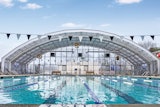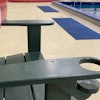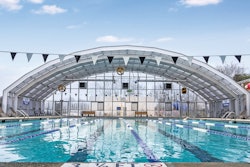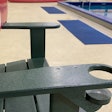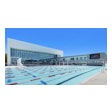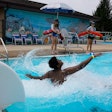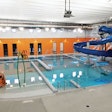Resurfacing an Old Pool Can Be Relatively Inexpensive
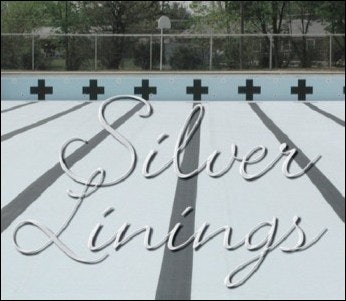
They begin their lives as bustling meccas of aquatic fun and competition. But over time, the most ill-kept of inground pools can closely resemble abandoned bomb shelters - empty bunkers of faded paint and crumbled concrete. Even active pools that appear perfectly functional from above the surface may be struggling to hold water underneath, as chemicals and freeze-thaw cycles wreak havoc on cementitious walls and floors.
Rather than rebuild, many pool operators are choosing to renovate their existing pools by simply - and quite affordably - covering their interiors with watertight materials such as fiberglass and flexible PVC. "There really aren't a lot of good techniques for patching cracks or extremely deteriorated concrete in pools," says Mike Walsh, president of Natare Corp., an Indianapolis-based installer of PVC pool-lining systems. "For less than $10 a square foot, you can make functional a facility that, if constructed from scratch, would cost five to 10 times that much."
Not only can these lining systems return a pool's functionality, they can spruce up its appearance, too - often without users aware that they're swimming within or standing on the product of a pool renovation project. "A layman walking into a renovated pool wouldn't know the difference," says Paul Walter, co-founder of Advanced Pool Coatings, which coordinates the installation of sprayed-fiberglass pool interiors out of its Roseville, Calif., headquarters. "In fact, we've done a lot of high schools around here, and when I do a residential pool, the customer might say, 'We've never seen a fiberglass surface.' I'll ask, 'Do your kids go to Belle Vista High School?' They say, 'Yeah.' And I say, 'They've been swimming in our product.' "
Though virtually undetectable to the untrained eye once installed, lining systems present pool operators with a wide range of installation considerations that they need to recognize well before taking the renovation plunge.
PVC liners work in concert with an underlayment of fleece or felt to produce a total thickness of roughly three-eighths of an inch. These components can be installed in any of three ways: loosely on top of each other, adhered to each other and the pool wall on site or fused together in the factory before being adhered to the pool wall. Some companies believe that bonding the layers keeps them stable during the filling and draining of the pool, as well as during aquatic programming - such as water aerobics - that involves heavy foot traffic. The prospect of the liner slipping and gathering with the pool full or sagging when emptied is eliminated, according to these installers. Other companies are content to let the water pressure of a filled pool hold the PVC in place.
The underlayer serves several purposes. It helps protect the underside of the PVC membrane from imperfections in the original pool substrate, allows air and moisture to dissipate underneath the membrane, and provides a comfortable, slightly resilient surface for pool users.
Membrane material is typically available in a variety of colors and decorative patterns, and arrives on site in 200-pound rolled sections, which when unfurled measure roughly 6 feet wide by 25 meters long by one-sixteenth of an inch thick. These dimensions not only make sense when installation involves 25- or 50-meter pools, but they also represent a size that two installers can handle with relative ease. "What makes the material unique is that it's not a thin, residential-type film that most people are used to," says Brian Whelan, vice president of sales and marketing for Canton, Mass.-based Sarnafil, a company best known for its waterproofing of roofs, but which has been renovating pools for more than 10 years. "It's a very heavy-duty commercial product specifically designed for this kind of application."
Installation begins by washing the original pool surface and clearing any loose debris from its walls and floor. Cracks and spalling in the substrate are patched using a trowel and a quick-set plaster or acrylic concrete patching compound. Larger cracks and expansion joints are sometimes further treated with a bridge of thin plastic, preventing the liner from sagging into these areas should they widen over time once the pool is filled and in use. Once all patchwork has sufficiently cured, an antimicrobial treatment may be applied using paint rollers to the repaired surface to prevent algae, fungi and other organisms from forming beneath the membrane.
The underlayer of fleece or felt is adhered to the pool's walls and floor using a solvent-based, non-water-soluble adhesive. The membrane layer then covers this underlayer. If laid "loosely," the membrane is at least attached to flanges at all penetration points - inlets, outlets, main drains and light fixtures - using hot-air welding. If the felt and membrane are bonded on site, the installation involves applying adhesive to the underside of the membrane using a paint roller before fitting it over and securing it to the previously installed felt layer. If the layers are bonded in advance, on-site installation is shortened by one step. Whether glued or loose in relation to the underlayer, membrane sections are positioned to overlap, with the resulting 2- to 4-inch overlays welded watertight. "It is literally a process of upholstery," says Walsh. "The material is rolled out and overlapped several inches, and then the overlap seams are fused together with heat to form a permanent bond."
While deep-water areas, diving wells and side walls receive sections of smooth PVC, surfaces on steps and in shallow-water areas that see high levels of foot traffic are fitted with textured PVC for slip-resistance. The entire installation process typically takes two to four workers two weeks to complete.
In addition to basic PVC resurfacing, specially cut sections of black PVC can be hot-air welded to the installed membrane as racing lanes along the pool bottom, as well as target crosses on the end walls. Custom-cut PVC logos can be welded to the membrane, too, giving high school and college competition facilities, for example, a distinctive appearance.
PVC even allows the pool's original configuration to be altered with relative ease. If the operator of a flat-bottomed pool would prefer a rounded interior, pieces of PVC-coated steel can be positioned in the pool prior to installation of the membrane to accomplish this metamorphosis. If a diving well is desired in a pool that doesn't have one, the pool can be reconfigured and a lining applied without concern about watertightness between old and new pool sections. "When all is said and done, it will look like a smooth, very uniform interior finish," Walsh says.
Another advantage of choosing PVC as a renovation material is its adaptability to temperature fluctuation. Its flexibility allows it to expand and contract through the changing seasons without detaching from the expanding and contracting substrate. In addition, extreme temperatures rarely hamper the installation of PVC. "It could be 25 degrees outside or it could be 110. The only problem we have when it gets colder is that the welding process is a little slower," says Steve Draughn, sales manager for RenoSys Corp., an Indianapolis-based pool renovation company.
Fiberglass provides another means by which pool operators can regain aesthetic appeal and functionality in their facilities. "One of the things fiberglass is known for is its ability to take a cracked pool and mend it," Walter says. "Fiberglass has the strength, so once you cover up a crack, you very seldom see a crack reappear."
While the PVC application process varies only slightly from one installer to the next, fiberglass can be applied to a pool surface in one of two distinctly different ways: by spraying it on as a wet mixture or by laying it by hand in the form of prefabricated mats.
In either case, preparation of the old surface typically begins by identifying substrate imperfections such as spalling and, if shallow enough, feathering the edges of these areas smooth with a disc sander. Areas of deep deterioration often require these surface voids to be replastered. For some projects, grinding away larger sections of surface area may be necessary if it is evident that body oils or other contaminants that will ultimately inhibit the fiberglass bonding process have penetrated the pool surface. For other projects, simply power washing the original surface may suffice in ridding the pool of old paint, algae and other materials that inhibit cohesion of special resins and fiberglass to the pool surface.
Surface preparation continues with the cutting of quarter-inch-deep grooves around locations where the fiberglass will ultimately terminate - namely, penetrations in the pool walls and floor. This will allow the fiberglass to be tucked into the grooves during the application process, with the grooves serving as a permanent locking mechanism.
All areas of the pool not requiring a fiberglass coating, such as the pool deck and penetrations, are masked off with tape and paper. The entire exposed surface is then sprayed with a coat of thin resin, which penetrates and seals pores in the plaster and concrete. Here's where technique begins to diverge based on the fiberglass product being applied.
For spray applications, the seal coat is allowed to cure before the entire pool receives a fresh coat of fiberglass. The fiberglass is applied using a spray gun that draws resin and a hardening catalyst into a mixing chamber before the mixture is propelled from the gun's nozzle 3 or 4 feet to the pool wall. At the same time, the gun is fed fiberglass rope that is chopped into inch-long pieces by a top-mounted, air-powered blade wheel. These freshly cut fibers are blown midair into the spray of resin and catalyst, and all three components quickly begin to solidify as one compound upon hitting the wall in an 18-inch-wide swath. "I describe it as looking like the floor of a barber shop," says Walter. "All those hairs are in all different directions - sticking up, sticking out, crisscrossing."
Crew members armed with ribbed aluminum rollers immediately flatten this mix before it completely hardens, forming a somewhat pliable fabric over the surface of the pool. Then, to ensure that no fibers have been left uncovered to protrude from the fiberglass layer, the gun is again used to apply another layer of resin.
Once this layer has cured, the pool is detailed. All masking is removed by cutting through the fiberglass overspray with utility knives. Termination points are carefully cut to leave fiberglass locked into the precut grooves. Crew members then examine the surface of the pool literally by hand, feeling for any remaining protruding fibers, which are cut or sanded off. (Once fiberglass has cured, these fibers become more like slivers and pose a potential hazard to swimmers.) Any other imperfections occurring during installation - for example, an insect caught in the fiberglass prior to curing or a blister caused by inadequate surface preparation - are corrected by cutting away the blemish, addressing any problems underneath and reapplying fiberglass to the affected area.
Finally, a finish coat designed to further smooth the surface and protect the fiberglass from pool chemicals is applied. The pool is once again masked off and the finish coat is sprayed on to a thickness of one-sixteenth of an inch, leaving a final overall thickness of the fiberglass renovation of about three-sixteenths of an inch. Pigment is mixed with the finish coat to provide the pool's desired color. Spray-applied fiberglass might take a half-dozen crew members a month to complete.
In the application of fiberglass mat, a seal coat of resin is applied to penetrate the substrate, followed by another type of resin specifically formulated to stand up to pool chemicals. Sections of fiberglass matting, which is thin enough to read through, are then cut from large rolls and laid on top of this fresh resin coat while it is still damp, forming a bond. Unlike PVC, where sections are laid to overlap, sections of fiberglass matting butt up against one another and are sealed by a second coat of resin. As this resin is rolled on, it is forced to penetrate the fiberglass mat, creating a bonded sandwich of resin around fiberglass. This step also helps remove air pockets and shape the fiberglass to the contours of the pool. This surface is sanded by hand to remove any sharp points, and a third coat of resin is applied, leaving a nonporous outer surface. Fiberglass matting, proponents argue, allows the pool's interior to be covered with a consistent thickness of renovation material, which including all resin layers amounts to about an eighth of an inch.
Resin containing black pigment can be applied to masked-off areas to differentiate racing lanes and targets, as well as to highlight steps.
Final cost of a project will vary by the size of the pool. The larger the pool, the lower the cost per square foot - as crew mobilization, labor and other fixed expenses are absorbed within the project's total price. While renovations involving PVC and fiberglass materials afford pool operators substantial savings over demolition and reconstruction, installers boast ongoing operational benefits, as well. Lining a pool with nonporous materials not only prevents leaking and the expense associated with replacing perhaps thousands of gallons of water per day, but it also inhibits the penetration of algae and bacteria in the tiny nooks and crannies of concrete and plaster pools, saving pool operators as much as 25 percent in chemical costs, according to Draughn.
Of course, no system is infallible, and while both PVC and fiberglass renovations have been known to last up to 20 years, warrantees offered typically range from five to 10 years. Temporary repairs of either system are possible using special underwater adhesives, allowing the pool to remain filled and operational. But when the time comes to completely replace either material, there can be drawbacks. Tearing out pool liners that have been bonded to the substrate is a process that may involve crowbars, grinders and a good deal of physical effort on the part of crew members. Still, there is no question about the value PVC and fiberglass can bring to a facility in the form of improved looks and extended life - without the ongoing concerns that exposed concrete and plaster repairs create.
"There are still plasterers out there," says Walter. "There are also people who look at fiberglass as a new product, and they shy away from it because they've never heard of it. But we find that those people who find out about it like it, and we get repeat business."
PVC business is on the rise, too, according to Walsh. "The use of PVC lining technology allows you to quickly, efficiently and cost-effectively restore the appearance of the pool to like-new," he says. "Because of that, it's being adopted more and more. Not because of its waterproofing functionality, but because it's a great way to make an old pool look good."










